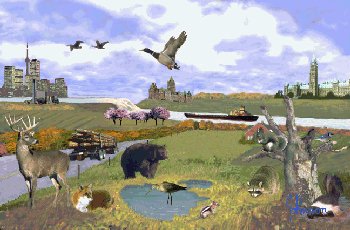An extensive system of waterways, including the St. Lawrence River and the Great Lakes, combines with surrounding rich fertile soils to create one of the most attractive and productive ecozones in Canada. The Mixedwood Plains Ecozone, encompassing a small area of 175 963 square kilometres, is bounded by three Great Lakes in southern Ontario and extends along the St. Lawrence shoreline to Quebec City. With its relatively mild climate, it represents the most populous and prosperous terrestrial ecozone.
Native communities, including the Mohawk, Algonquian, Iroquoian, and Cree, inhabited the favoured Mixedwood Plains long before European settlement. The earliest French arrivals, also recognizing the St. Lawrence River's many advantages, established themselves along the shoreline at Quebec City in 1608, Trois-Rivières in 1634, and Montreal in 1642. British settlers founded the towns of Niagara, Hamilton, and Toronto in Upper Canada during the mid-18th century.
Interlaced with national and international transportation routes, the Mixedwood Plains have become the industrial and commercial heartland of Canada. Urban centres encroach on remaining prime agricultural land as the population continues to grow. Settlement and resource extraction dramatically alter the land. Striking a balance between economic development and ecological sustainability has become a challenge for today’s residents and for future generations.
